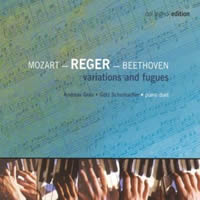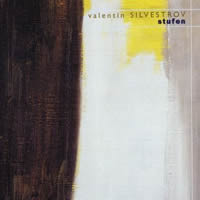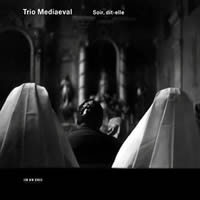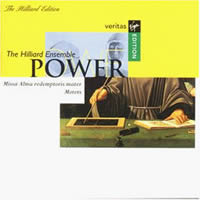Walt’s Ratatouille 7.
|
Walt Mundkowsky [December 2004.]
“variations and fugues.” Max REGER: Variations and Fugue on a Theme by Mozart, Op. 132a (1914); Variations and Fugue on a Theme by Beethoven, Op. 86 (1904). W.A. MOZART: Fugue in C minor, KV 426 (1783). Ludwig van BEETHOVEN: Grosse Fuge, Op. 134 (1826). Andreas Grau, Götz Schumacher (piano duet). col legno edition WWE 1CD 20108 (http://www.col-legno.de/). Distributed in the US by Qualiton (http://www.qualiton.com/). Hard on the instrument and on the players, Beethoven’s piano-four hands transcription of his Grosse Fuge is also hard to find. The composer’s most radical 15 minutes came about after his publisher commissioned a hack piano reduction. Enraged, Beethoven took on the task without compromises or practical considerations. (How a fortepiano might cope with the onslaught, I can only imagine — a pity no HIP duo has tried it.) The keyboard Grosse Fuge is much clearer vertically and the want of string-quartet plush means a bumpier ride — both advantages. I see a vehement Beethoven at the piano, punching it out. Familiarity and repeat hearings don’t dilute the power of this unclassifiable, unique score; it never goes down easily. A curiosity in Beethoven’s output (the separate opus number is a clue), it doesn’t “fit” next to other works. Indeed, the brute force and density of intellect make it sound entirely up-to-date. (The Grosse Fuge is the only pre-Schoenberg piece the Arditti Quartet does.) Andreas Grau and Götz Schumacher are a thriving piano duo (no small feat). I’d call their Stockhausen Mantra (Wergo WER 6267-2) second only to the composer-sanctioned DG vinyl (now a very expensive Stockhausen Verlag disc, ST116-2, which CDeMUSIC carries). They essay the Grosse Fuge from a contempo angle — clean and hard-hitting. Meno mosso e moderato sections are downplayed for strong contrast, but avoid undue sentiment. Recorded with rattling (in both senses) impact, this is the one for now. As noted, Grosse Fuge couplings are dubious. Reger’s prolix Mozart and Beethoven sets perch at either end. Delivered straight up, they seem dry and endless. The KV 426 Fugue, from Mozart’s Bach studies, motors along here without period attire. A lively ECM New Series double (465 062-2) from András Schiff and Peter Serkin shows stylistic awareness even in disagreement (the notes call the star soloists “protagonists”). KV 426 and Reger’s Beethoven emerge more slowly and eventfully. Other versions of the piano Grosse Fuge barely count. The 1969 Demus / Shetler (now in an eight-disc DG brick, 4537332) isn’t forward enough, in execution or sound. Pedestrian accounts on fonè and Stradivarius have departed over here; each had the Grosse Fuge in the company of Beethoven’s early salon-aimed items for two — dismal and revealing. On Thorofon (O/P, but still on amazon.de), Stephan Möller enters one part into a computing Bösendorfer 290SE and then performs the other. Any gain in unanimity is defeated by the smudged passagework. I haven’t yet heard Mayumi Kameda and Jean Jacques Balet’s, on Cyprès CYP1610 (1997). Their disc displays nerve (a four-hands Le Sacre and La Mer), but then they’ve done Carmina Burana (Cascavelle VEL 1009) on two pianos.
Valentin SILVESTROV: Stufen (1982, rev. 1998); Ustnaya Muzyka 1 and 2 (1998, 1999). Jana Ivanilova (sop.); Alexei Lubimov, Silvestrov (piano). Megadisc MDC 7832 (http://www.megadisc.be/). My window on Silvestrov is slender and perhaps to his advantage — solo piano, chamber groups, and above all the song cycles. ECM New Series recently issued a 1986 taping of Silent Songs (1974-77) as 1898/99 (2 CDs). It’s superb, but I often have the Megadisc in my head (MDC 7840/41, rec. 2000). Those I’ll cover soon. Stufen (Degrees, Steps) is his third such sequence, and every bit the earlier work’s equal. Silvestrov’s most intimate scores take the “from afar, listening raptly” motto as gospel. In Stufen he plies “the impression of leafing through a book or visiting the various rooms of a house….” Afar in time as in acoustic space; of the seven poets, Mandelstam (d. 1938) is the nearest to us. Like recollection itself, the 11-song layout retraces ground it has already trod. No. 2’s “halfway to sleep” leads to “sleepy dusk” (no. 4), “the fluttering of recurrent dreams” (no. 5), sleep “prophetic and opaque” (no. 7) and “To Sleep” (no.9), in which the poet needs salvation “from curious conscience, … burrowing like a mole.” The preceding entry has “A golden task — to shed the burden of time.” Pushkin’s famous “Elegy” sits at the center, its “agitated sea of the future” reprising the “waves of the tide” of no. 2, whose “Stygian tenderness” crops up again in the Mandelstam finale. This flurry of cross-relations binds the similarly themed poems closer together. Silvestrov suggests performing the group attacca, which the disc doesn’t precisely do. (Numbers are of course separately tracked.) After a few challenging intervals in the opener (“Ahead lies the inevitability of the journey”), the cycle settles into slowly winding, downward-turning melodic paths of great beauty. (Influence-spotters can detect Mahlerian echoes and a dash of the eerie quiet in Bartók’s “Night Music.”) The hanging, pedaled haze in the piano part often leaves the singer exposed; rumbling trills and arpeggiated figures predominate. To a listener, psychologizing is absent. Stufen posits a way to extend the poems, and letting go of them is difficult, so the lengthy codas (a Silvestrov trademark) express more point than the tactic sometimes provides. Soprano Jana Ivanilova and Alexei Lubimov (the composer’s pianist of choice) seem like the last word. Her light, pellucid instrument responds completely to the imposed restraint. She can reduce her focused tone to a fragile but sustained thread, a haunting effect in nos. 3, 9 and 10. The archaic melody in no. 2 is securely sent aloft (her hums at the end clinch it) and the finale is even more impressive, as she wafts the self-reproaches in ever quieter circles. Lubimov makes each of the very similar postludes wholly distinctive. To create a resonance chamber for Stufen, the disc finishes with the composer doing two meandering piano pieces (“rather like dozing,” Silvestrov says, linking them to the songs). Palette and perspectives serve the music ideally, ditto the illuminating and well-designed booklet. Stufen premiered at Moscow’s Festival Alternativa 1989 and was in col legno’s taping of the event (AU 31840, 5 CDs, O/P). The sound is fine given the situation, but it does favor Lubimov’s piano. Svetlana Savenko’s voice, darker and heftier than Ivanilova’s, can’t get so blanched and wan. Silvestrov altered the opening in 1998, adding two works and axing one, and may have revisited other areas, to judge by the timings.
“Soir, dit-elle.” Leonel POWER: Missa Alma redemptoris mater. Oleh HARKAVYY: Kyrie (2002). Gavin BRYARS: Laude novella (Lauda II) (2002); Ave regina gloriosa (Lauda VII) (2003); Ave donna santissima (Lauda III) (2002); Venite a laudare (Lauda I) (2002). Andrew SMITH: Ave Maria (2000); Regina caeli (2002). Ivan MOODY: The Troparion of Kassiani (1999); A Lion’s Sleep (2002). Trio Mediaeval. ECM New Series 1869 (http://www.ecmrecords.com/). Also distributed in the US by iclassics.com (http://www.iclassics.com/). Except for the presence of Leonel Power (d. June 5, 1445, Canterbury), this disc wouldn’t rate a mention. Ultimately it has no serious designs; Power’s mass setting is interrupted at the close of each movement by contemporary stabs at medieval-ness, and text translations are shunned. The result is a patchwork where the sung words seemingly don’t matter. If it needs saying, Power’s music is easily the most complex and startling of the lot. Missa Alma redemptoris mater (tracks 2, 5, 9, 13) may date from the 1420s; certainly it’s later than his Old Hall Manuscript pieces (c. 1410-1415). History calls it the first mass by a single hand to employ the same cantus firmus in each section (in the bottom voice). The contrary lines of motion, superimposed meters and elaborate counterpoint can be found in other efforts of the age, but rarely with such forceful invention. Missa also points forward to the less convoluted styles of Dunstaple (d. 1453) and Dufay (d. 1474). Trio Mediaeval looks ready to assume the Anonymous 4 mantle when the veteran quartet ceases activity in the near future, though the newbies are not as keen on scholarly digging and produce a less refined blend (no bad thing). Their pinpoint intonation ensures that the adventurous harmonies score, even when the one-voice-per-part setup is underPowered. I pray some consumers will advance to the sole all-Power disc, by the Hilliard Ensemble (a midprice Virgin Veritas reissue, 61345). Made in 1980, near the start of their remarkable run, it’s one of their very best. For historical context (something the ECM flees from), try the Hilliard’s Old Hall Manuscript sample (Virgin Veritas 61393). It followed the Power by a decade and marked the end of leader Paul Hillier’s tenure (and the gang’s best days). I hear Virgin hasn’t kept Hillier’s splendid commentaries in toto, a shame. ECM’s recording, captured at their often-used St. Gerold location, is austere but luscious. I can’t vote for any of the ballast around the Power because it all failed to register. On the “Evening, she said” title: The words were imbedded in the shot (from a Godard video) on Trio Mediaeval’s debut ECM cover and they survived. A bow to “Already it is dusk,” the heading of Górecki’s First Quartet? Trio Mediaeval has a useful website, here.
[More Walt Mundkowsky, Walt's Ratatouille]
[Previous Article:
Random Noise 9: Philip Glass as Culture Meter, etc.]
[Next Article:
Rule of the Plowman]
|



